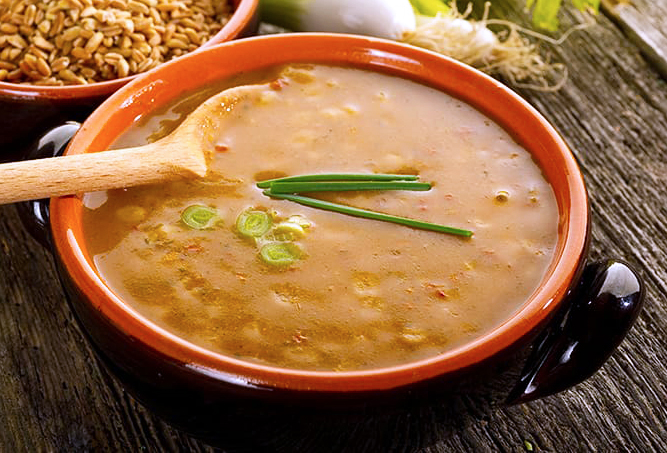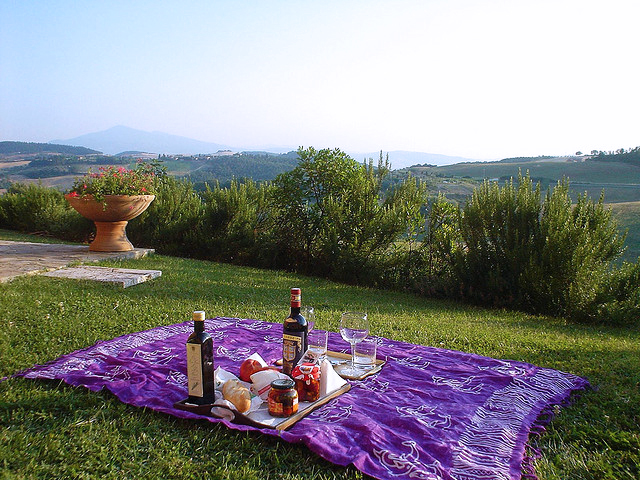With all of the riches that are found within Italian cuisine, it startles many visitors to the region of Tuscany that the food is less interesting than in Sicily, Naples, Rome or anywhere in the Emilia Romagna. Much of the region is landlocked, with a climate that is ideal for growing grapes and olives, but is not otherwise suited for extensive agriculture. That is why the cuisine of Lucca is so compelling. It is epitomized by the city’s most representative dish – Tordelli alla Lucchese. In Italy, you can determine a region’s historical affluence by the dominant type of pasta. Flour and water, perhaps with some oil, produces a pale-colored pasta favored by those with limited means. Flour with a few eggs yields a pale yellow quality and was the pasta of the middle class. Flour with a lot of eggs, creating a brilliant yellow hue was for the wealthy. Lucca, with banking and a robust silk trade, had money and not surprisingly, Tordelli alla Lucchese is a bright yellow pasta stuffed with seasoned meats and topped with a heavily meat-laden sauce.
Zuppa di Farro
This soup is an institution in Lucca and its surrounding area.
Ingredients
- 1 small onion, finely chopped
- 1 small carrot, finely chopped
- 1 stick celery, finely chopped
- 2 tbsp olive oil
- 2 ounces pancetta
- 1 sprig rosemary
- 4 to 5 fresh sage leaves
- 1 pinch salt and pepper, to taste
- 8 oz peeled tomatoes
- 12 oz can borlotti beans
- 3 cups vegetable stock, more to taste
- 3 cups water
- 1 cup of farro (semi-pearled or pearled)
- 1 scallion, chopped
- 1 splash extra-virgin olive oil for serving
Preparation
Heat the olive oil in a wide soup pot or saucepan; add the chopped onion, carrot and celery and gently cook until soft and translucent. Add the pancetta and continue cooking until the fat has melted. Add herbs, peeled tomatoes and season with salt and pepper. Add the borlotti beans, along with their liquid. Stir to combine everything and add 2 cups of vegetable stock, plus 2 cups of water. Bring the mixture to a simmer, cook 10 minutes uncovered and remove from heat. Remove the rosemary stick and using a blender or food processor, blend until smooth. Add the farro to the bean purée, along with a cup of vegetable stock and a cup of water. Continue cooking over a low flame for 30 to 40 minutes, stirring occasionally, until the farro is cooked al dente. Serve with chopped scallion, freshly ground black pepper and extra virgin olive oil drizzled over the top.
Tordelli alla Lucchese
Admittedly, this is a very long recipe with many ingredients and many steps; however, one cannot discuss the cuisine of the province without including its signature recipe, no matter how complex it may be.
Ingredients
For Il Ripieno – the Meat Filling
- 1 ½ lb meat (beef, pork, rabbit), cut into 3”x 3” cubes
- salt and fresh ground black pepper, to taste
- 1/4 cup chopped fresh herbs (sage, marjoram, thyme, rosemary and Italian parsley)
- 1/8 tsp ground cinnamon
- 1/8 tsp ground cloves
- 1/4 cup plus 3 tbsp extra-virgin olive oil
- ½ pound Swiss chard, well washed and stemmed
- ½ cup day-old course bread crumbs
- ½ cup chopped cured meats (such as mortadella, salami or prosciutto)
- 5 tbsp freshly grated Parmigiano-Reggiano cheese
- 1 egg, beaten
- beef broth, as needed
Preparation
Preheat the oven to 400°F. Season the meat with salt, pepper, fresh herbs, spices and 1/4 cup of the olive oil. Place the mixture in a roasting pan and roast for 25 to 30 minutes, stirring occasionally, until the meat is well done.
While the meat is cooking, place the Swiss chard with the water still clinging to its leaves into a medium pot, cover and heat it over medium-high flame, stirring occasionally. When the chard has wilted (about 7 minutes), drain and squeeze out as much water as possible. Chop the chard roughly.
In a medium frying pan, heat the remaining 3 tablespoons of olive oil and add the chopped Swiss chard. Cook it for 2 minutes, then set aside to cool.
When the meat is done, place it in the bowl of a food processor along with its roasting juices, the Swiss chard, bread crumbs, cured meat, Parmigiano-Reggiano and an egg. Pulse until everything is well blended. If the mixture is dry, add some beef broth, a tablespoon or so at a time. Adjust the seasoning and set the mixture aside, allowing it to cool before using.
For the Tordelli Dough
- 4 ½ cups unbleached with flour
- 5 large eggs, plus 5 large egg yolks
- 2 tbsp extra-virgin olive oil
- ½ cup water
- 2 tsp salt
Preparation
Mound the flour on a clean work surface and form a well in the center. Add the eggs and the egg yolks to the well and then add the olive oil, ½ cup of the water and the salt. Use one hand to mix the eggs and the other to hold up the wall of the flour well from the outside. Gradually begin incorporating the flour from the inside wall of the well into the eggs. When the eggs are no longer runny, push in the walls of the flour and work the mixture into a mound of soft crumbs. Gather the mixture together and begin working it into a ball. If it seems too dry, add up to 1/4 cup more water, a tablespoon at a time. Once the dough has formed, knead it vigorously for 10 minutes, until it is elastic and smooth. Cover it with a kitchen towel and let it rest for an hour.
To make the tordelli, lightly flour the work surface. Pinch off a baseball-sized portion of dough and flatten it. Using a rolling pin, roll into a rectangular sheet, no more than 1/8 inch thick (preferably even thinner). With a knife, trim the pasta into a long strip, approximately 3 inches wide.
Working quickly so the dough does not dry out, pinch off pieces of the meat filling and roll them to form small balls, about ½ inch in diameter. Center the meat, approximately 2 inches apart in the middle of the strip of dough. Fold the pasta over the meat, pressing down on the pasta between each ball to seal the dough. Cut out the tordelli by using a pastry wheel with a wavy edge to make half-moon shapes. Repeat the process with the rest of the filling and dough. Dry the tordelli on a flat screen until ready to use. If you are not going to use the tordelli within 24 hours, cover lightly and refrigerate. They will also keep frozen for 2 months (thaw them in the refrigerator before cooking).
Bring a large pot of generously salted water to a boil. Add a tablespoon of olive oil to keep the pasta from sticking together. Cook the tordelli for approximately 8 minutes, until al dente.
For the Ragu di Carne – Meat Sauce
- 1 large yellow onion, finely chopped
- 2 stalks celery, finely chopped
- 1 medium carrot, finely chopped
- 4 cloves garlic, finely chopped
- 1/4 cup extra-virgin olive oil
- ½ lb ground pork
- ½ lb ground beef
- ½ lb ground veal
- 4 thin slices prosciutto, chopped
- 2 cups red wine
- 1 (28-ounce) can whole plum tomatoes
- 1 cup crushed tomatoes – not puree
- 1 cup water
- ½ tsp salt
- ½ tsp crushed red pepper flakes
- 1/4 tsp fresh ground black pepper
Preparation
In a large saucepan, heat the olive oil over a medium flame and sauté the onion, celery, carrot and garlic until tender and translucent, about 15 minutes. Just before the mixture begins to color, add the pork, beef, veal and prosciutto. Continue cooking until the meat is browned, about 8 or 9 minutes.
Add the wine and raise the flame to reduce the liquid. Cook for 5 to 10 minutes. Add the tomatoes and cook covered over medium-low flame for 45 minutes. Add the water, salt, red pepper flakes and black pepper and cook for an additional hour until the sauce is thick and flavorful. Drain the cooked tordelli; mix with the meat sauce and serve with grated Parmigiano-Reggiano cheese.





